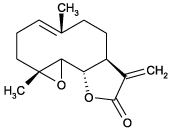Replaces Prod. #: ALX-350-258
Sesquiterpene lactone. Widely used as an herbal remedy for arthritis and migraine. Has anti-inflammatory, antisecretory and spasmolytic activity. Specifically inhibits activation of NF-κB by preventing the degradation of IκBα and IκBβ. Inhibits activation of MAP kinase (MAPK/ERK) and generation of leukotriene B4 and thromboxane B2. Potent anticancer agent. Induces apoptosis in various cancer cell lines. Specifically inhibits histone deacetylase 1 (HDAC1) without affecting other class I/II HDACs. Inhibits tubulin carboxypeptidase (TCP) activity.
Product Details
| Alternative Name: | (1aR-[1aR*,4E,7aS*,-10aS*,-10bR*])-2,3-6,7,7a,8,10a,10b-Octahydro-1a,5-dimethyl-8-methyleneoxireno[9,10]cyclo deca[1,2-b]furan-9(1aH)-one |
| |
| Formula: | C15H20O3 |
| |
| MW: | 248.3 |
| |
| Source: | Isolated from feverfew (Chrysanthemum parthenium) leaves. |
| |
| CAS: | 20554-84-1 |
| |
| MI: | 14: 7048 |
| |
| RTECS: | LY4220000 |
| |
| Purity: | ≥97% (HPLC, TLC) |
| |
| Appearance: | White to off-white crystalline solid. |
| |
| Solubility: | Soluble in DMSO (100mg/ml), dichloromethane (50mg/ml) or 100% ethanol (20mg/ml). |
| |
| Shipping: | Ambient Temperature |
| |
| Long Term Storage: | -20°C |
| |
| Regulatory Status: | RUO - Research Use Only |
| |
Please mouse over
Product Literature References
A small-molecule inhibitor of the NLRP3 inflammasome for the treatment of inflammatory diseases: R.C. Coll, et al.; Nat. Med.
21, 248 (2015),
Application(s): Cell Culture,
Abstract;
Elevated Serum Antibody Levels against Cyclin L2 in Patients with Esophageal Squamous Cell Carcinoma: H. Shimada, et al.; J. Cancer Sci. Ther.
7, 60 (2015),
Application(s): Cell Culture,
Full Text
The Cytokine Release Inhibitory Drug CRID3 Targets ASC Oligomerisation in the NLRP3 and AIM2 Inflammasomes: R.C. Coll, et al.; PLoS One
6, e29539 (2011),
Abstract;
Parthenolide inhibits tubulin carboxypeptidase activity: X. Fonrose, et al.; Cancer Res.
67, 3371 (2007),
Abstract;
Parthenolide specifically depletes histone deacetylase 1 protein and induces cell death through ataxia telangiectasia mutated: Y.N. Gopal, et al.; Chem. Biol.
14, 813 (2007),
Abstract;
Parthenolide-induced apoptosis in multiple myeloma cells involves reactive oxygen species generation and cell sensitivity depends on catalase activity: W. Wang, et al.; Apoptosis
11, 2225 (2006),
Abstract;
Antitumor agent parthenolide reverses resistance of breast cancer cells to tumor necrosis factor-related apoptosis-inducing ligand through sustained activation of c-Jun N-terminal kinase: H. Nakshatri, et al.; Oncogene
23, 7330 (2004),
Abstract;
Involvement of proapoptotic Bcl-2 family members in parthenolide-induced mitochondrial dysfunction and apoptosis: S. Zhang, et al.; Cancer Lett.
211, 175 (2004),
Abstract;
The anti-inflammatory natural product parthenolide from the medicinal herb Feverfew directly binds to and inhibits IkappaB kinase: B.H. Kwok, et al.; Chem. Biol.
8, 759 (2001),
Abstract;
Paclitaxel sensitivity of breast cancer cells with constitutively active NF-kappaB is enhanced by IkappaBalpha super-repressor and parthenolide: N.M. Patel, et al.; Oncogene
19, 4159 (2000),
Abstract;
Sesquiterpene lactones inhibit inducible nitric oxide synthase gene expression in cultured rat aortic smooth muscle cells: H.R. Wong & I.Y. Menendez; BBRC
262, 375 (1999),
Abstract;
The antiinflammatory sesquiterpene lactone parthenolide inhibits NF- kappa B by targeting the I kappa B kinase complex: S.P. Hehner, et al.; J. Immunol.
163, 5617 (1999),
Abstract;
Sesquiterpene lactones specifically inhibit activation of NF-kappa B by preventing the degradation of I kappa B-alpha and I kappa B-beta: S.P. Hehner, et al.; J. Biol. Chem.
273, 1288 (1998),
Abstract;
Inhibition of the expression of inducible cyclooxygenase and proinflammatory cytokines by sesquiterpene lactones in macrophages correlates with the inhibition of MAP kinases: D. Hwang, et al.; BBRC
226, 810 (1996),
Abstract;
Feverfew extracts and parthenolide irreversibly inhibit vascular responses of the rabbit aorta: R.W. Barsby, et al.; J. Pharm. Pharmacol.
44, 737 (1992),
Abstract;
Inhibition of 5-lipoxygenase and cyclo-oxygenase in leukocytes by feverfew. Involvement of sesquiterpene lactones and other components: H. Sumner, et al.; Biochem. Pharmacol.
43, 2313 (1992),
Abstract;
A comparison of the effects of an extract of feverfew and parthenolide, a component of feverfew, on human platelet activity in-vitro: W.A. Groenewegen & S. Heptinstall; J. Pharm. Pharmacol.
42, 553 (1990),
Abstract;












